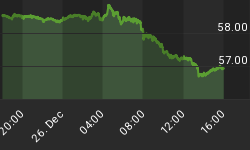Announcement:
We're opening the trading room to visitors on Thursday, November 29. Come trade alongside us! Details will be announced on TOTM's blog page.
Profiting by Having an Edge on the Euro
Getting a good entry on a currency trade can be extremely rewarding, as currencies tend to move in a more steady fashion than equities. Once your entry has been confirmed, it's often a relatively simple matter to set stops and follow the momentum until conditions change. So why isn't everyone making money this way?
Because finding good entries is tricky. It helps to have an edge.
Take for example a recent shorting opportunity in the Euro. From the daily chart, the entry window around October 17 does not stand out very well. In fact, the Euro had surpassed the 61.8% and 76.4% Fibonacci retrace levels, and it almost looked like it was ready to climb to new highs. There were two momentum signals to the short side around October 21, as shown by the two line indicators at the bottom of the chart, but the more important CCI histogram didn't turn red until much later, near the end of the move.

As we said, it helps to have an edge. At TOTM, we watch the U.S. Dollar Index closely as a tool for indentifying or confirming trades in the Euro as well as other markets. The Dollar Index values the U.S. Dollar based on a basket of currencies, and with the inverse of the Euro playing the largest role. The inverse Euro constitutes 57.6% of the value of the Dollar Index. In most cases, to be able to trade one is to be able to trade the other. (This is nice, as the actual futures contract for the Dollar isn't a very attractive instrument to trade. It trades with fairly low volume - only about 15% of the volume traded for the Euro contract.)
Let's examine the Euro short trade with the added information gained from tracking the Dollar. From that perspective, the signal was much clearer.
Based on our foremost Elliott Wave count for the Dollar, we were looking for a possible wave 'ii' low, to be followed by a strong upward move. One candidate for that low appeared on October 5, and that produced a good long signal for the Dollar, corresponding with a short signal for the Euro. However, that first move faltered after just a few days, and we were again seeking a low that finally arrived on October 17 - right at an attractive 76.4% retrace and a retest of the broken channel line.

Whereas the Euro did not present a good retrace value as a basis for a short entry, the Dollar produced a useable 76.4% retrace on its second attempt to form a low. In fact, both Dollar lows on Oct. 5 and Oct. 17 were valid entries and could be translated to short Euro trades with fairly low risk, as we show in the latter half of this article.
Soon after each of the Dollar lows on Oct. 5 and Oct. 17, basic momentum and CCI indicators produced "long" signals, as shown on the 120-minute Dollar chart below. The signals were more important, having come after fairly clean retracements in to Fibonacci levels. Even though the first "long" Dollar trade ultimately failed, a good entry and attention to the indicators ensured that any loss was minimal.

The corresponding Euro chart gave excellent entry signals to the short side. Even though there weren't nice Fibonacci retracements, the Dollar gave us the needed clues. Indicators on both the Dollar and the Euro charts on a smaller timeframe confirmed each other and confirmed the short entries in the Euro.

No doubt there were many traders out there who were looking for the Euro continuation trade to the long side. That's understandable, as the Euro can often be difficult to count. However, TOTM's working count in the Dollar saved our members that hassle and kept them on the right side of the swing trade. If you think you could benefit from having these kinds of entries pointed out, consider exploring TOTM with an introductory month-long trial membership. Just $30 gets you full access to our analysis on ALL timeframes ranging from months to minutes, plus access to our live trading room.
Trading futures and options involves the risk of loss and is not suitable for all investors. Nothing in this article should be construed as a recommendation to buy or sell financial instruments.
















